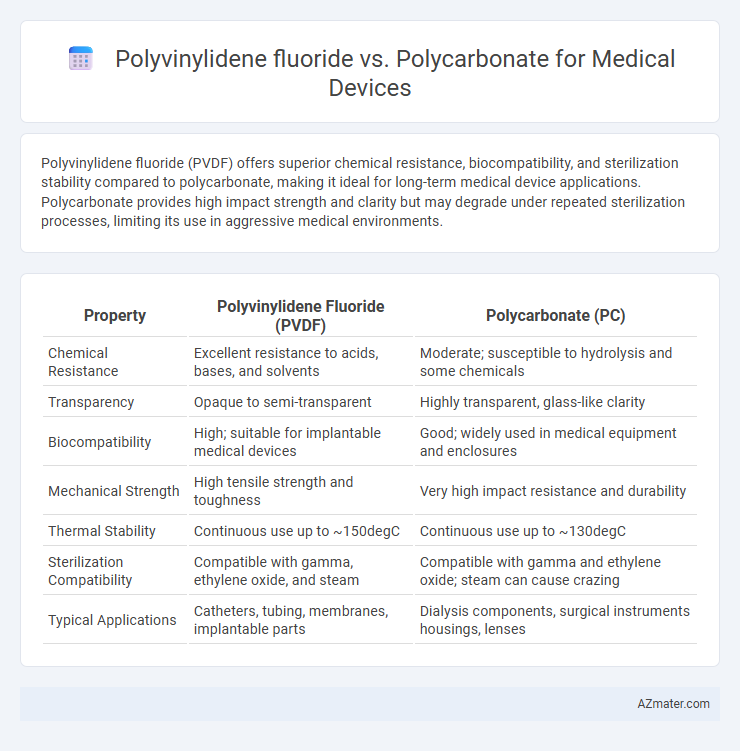Polyvinylidene fluoride (PVDF) offers superior chemical resistance, biocompatibility, and sterilization stability compared to polycarbonate, making it ideal for long-term medical device applications. Polycarbonate provides high impact strength and clarity but may degrade under repeated sterilization processes, limiting its use in aggressive medical environments.
Table of Comparison
| Property | Polyvinylidene Fluoride (PVDF) | Polycarbonate (PC) |
|---|---|---|
| Chemical Resistance | Excellent resistance to acids, bases, and solvents | Moderate; susceptible to hydrolysis and some chemicals |
| Transparency | Opaque to semi-transparent | Highly transparent, glass-like clarity |
| Biocompatibility | High; suitable for implantable medical devices | Good; widely used in medical equipment and enclosures |
| Mechanical Strength | High tensile strength and toughness | Very high impact resistance and durability |
| Thermal Stability | Continuous use up to ~150degC | Continuous use up to ~130degC |
| Sterilization Compatibility | Compatible with gamma, ethylene oxide, and steam | Compatible with gamma and ethylene oxide; steam can cause crazing |
| Typical Applications | Catheters, tubing, membranes, implantable parts | Dialysis components, surgical instruments housings, lenses |
Introduction: PVDF vs Polycarbonate in Medical Devices
Polyvinylidene fluoride (PVDF) offers exceptional chemical resistance and thermal stability, making it ideal for medical devices exposed to aggressive sterilization processes. Polycarbonate provides high impact resistance and transparency, suitable for devices requiring durability and visual inspection. Both polymers serve distinct functions: PVDF excels in biocompatibility and chemical inertness, whereas polycarbonate balances strength and clarity in medical applications.
Chemical Structure and Composition
Polyvinylidene fluoride (PVDF) is a semi-crystalline fluoropolymer composed of repeating vinylidene fluoride units (-CH2-CF2-), providing excellent chemical resistance and stability against solvents, acids, and bases, making it ideal for medical devices exposed to harsh chemical environments. Polycarbonate (PC) consists of carbonate groups linked by bisphenol A units, resulting in an amorphous, transparent polymer with high impact resistance but lower chemical resistance compared to PVDF. The fluorinated backbone of PVDF enhances biocompatibility and reduces permeability, whereas PC's aromatic carbonate structure offers toughness and optical clarity, influencing their specific applications in medical device manufacturing.
Mechanical Strength and Durability
Polyvinylidene fluoride (PVDF) offers excellent chemical resistance and mechanical strength, maintaining integrity under high stress and repeated sterilization cycles, making it ideal for medical devices requiring long-term durability. Polycarbonate displays superior impact resistance and toughness but may degrade when exposed to certain sterilization methods and harsh chemicals, limiting its durability in some medical environments. PVDF's resistance to UV radiation and hydrolysis further enhances its mechanical longevity compared to polycarbonate in demanding clinical applications.
Biocompatibility and Safety
Polyvinylidene fluoride (PVDF) offers superior biocompatibility with excellent chemical resistance and low toxicity, making it ideal for long-term medical device implants and fluid handling components. Polycarbonate, while providing high toughness and clarity, may pose higher risks of leaching bisphenol A (BPA) and requires thorough biocompatibility testing for sensitive applications. Safety considerations favor PVDF in contexts demanding minimal biological interaction and maximum chemical stability.
Sterilization Methods and Resistance
Polyvinylidene fluoride (PVDF) offers high chemical resistance and excellent compatibility with sterilization methods such as gamma radiation, autoclaving, and ethylene oxide, making it ideal for long-term medical device applications. Polycarbonate (PC) provides good impact resistance but is less resistant to aggressive sterilization processes like gamma radiation and high-temperature steam, potentially leading to material degradation over time. Choosing PVDF over PC enhances durability and maintains structural integrity during repeated sterilization cycles critical for medical devices.
Chemical Resistance and Reactivity
Polyvinylidene fluoride (PVDF) exhibits superior chemical resistance compared to polycarbonate (PC), effectively withstanding strong acids, bases, and solvents commonly encountered in medical device sterilization processes. Polycarbonate tends to degrade or craze when exposed to harsh chemicals, limiting its use in chemically aggressive environments. PVDF's low reactivity and excellent resistance to chemical corrosion make it a preferred choice for medical devices requiring high durability and chemical stability.
Optical and Physical Properties
Polyvinylidene fluoride (PVDF) offers excellent chemical resistance and high mechanical strength, making it ideal for durable medical devices requiring sterilization. Polycarbonate (PC) provides superior optical clarity and impact resistance, essential for applications needing transparent components such as lenses or protective covers. While PVDF excels in chemical and UV stability, polycarbonate delivers better light transmittance and dimensional stability in medical device manufacturing.
Processability and Manufacturing Flexibility
Polyvinylidene fluoride (PVDF) offers excellent chemical resistance and high thermal stability, making it ideal for medical devices requiring sterilization and long-term durability, while its processability is challenging due to high melting temperatures and viscosity. Polycarbonate (PC) provides superior impact strength and optical clarity with easier injection molding and faster cycle times, enhancing manufacturing flexibility for complex, precision components. Selecting PVDF suits applications needing robust chemical resistance and biocompatibility, whereas PC excels in rapid prototyping and large-scale production where moldability and dimensional stability are critical.
Regulatory Compliance in Healthcare
Polyvinylidene fluoride (PVDF) demonstrates superior compliance with FDA and ISO biocompatibility standards for medical devices, particularly in implantable applications due to its chemical resistance and non-toxicity. Polycarbonate (PC), while widely used for its strength and transparency, must undergo rigorous testing to meet regulatory requirements concerning sterilization methods such as gamma radiation and ethylene oxide. Device manufacturers prefer PVDF in applications demanding long-term durability and stable performance under regulatory scrutiny in healthcare environments.
Cost Considerations and Market Trends
Polyvinylidene fluoride (PVDF) offers a cost advantage over polycarbonate (PC) in medical device manufacturing due to its lower raw material expenses and ease of processing, which reduces overall production costs. Market trends indicate a growing preference for PVDF in applications requiring chemical resistance and biocompatibility, while PC remains favored for its toughness and optical clarity in transparent medical components. The expanding demand for cost-effective, durable, and chemically resistant materials drives increasing adoption of PVDF, especially in sterilizable and chemically aggressive environments.

Infographic: Polyvinylidene fluoride vs Polycarbonate for Medical Device
 azmater.com
azmater.com